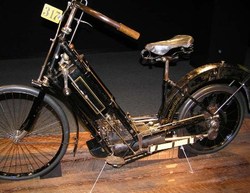The Motorcycle from the 1870's to 1905:
The Beginnings of Motorcycle Development!
The steam powered Roper, shown on the first page, was the first self powered two wheeler, but the Dammlier-Benz is usually considered to be the first true motorcycle because it was powered by an internal combustion engine. The Dammlier machine is dated 1885. Often called the espiner, german for "one track." It produced around a half horse power and could go several miles per hour. Performance stats estimate it would accelerate 0 to 4mph in 20 seconds. It was called the "bone shaker", no explanation needed! The bike would take about an hour to get running, when running could go only several hundred feet before stopping, and I doubt that it had a warranty! The original bike was destroyed but several sample of the original were built for museums a number of decades ago.
Significant traits of the early years of the motorcycle!
The first motorcycles were just engines attached to bicycle like frames. Simple, crude, little development, unsafe, and all were very different. It could be said that the first motorcycles were just mechanical experiments. Between 1898 and 1908, there were hundreds of little shops emerging which built some sort of motorcycle. There were few standards and many variations. Even when a machine was built, there were usually few made and as they were made, ongoing changes might be put into place. As an example, when Harley Davidson began production in 1903, their first year netted only 1 motorcycle built. The next year only two, in 1905, 8 motorcycles, and the numbers remained low until the 1909 when 1,149 units were built. This was before mass production and dealership chains. Things were simple. Several other notes, nearly all riders maintained their own machines with shops being used for only major repairs. Tires were short lived and nearly all bikes were belt drive. Belts were either leather straps or rubber belts. There was an occasional chain and a few shaft drive machines existed prior to 1910, but the belt was the dominant norm. The belt was popular because it functioned as both a simple transmission and the link between engine and wheel.
Because there were no transmissions (till after 1904-5), the bike would be push or pedal started, then the rider would jump on as it moved down the road. Kick starters did not become common till the late teens. If there was a brake, it would be a bar which could be pressed against one of the wheels. The first mechanical brakes came about after 1905. Lighting, if there was any, would be a kerosene lamp attached to the handle bars. The first races were primarily "reliability" competitions rather than speed related races. The speed came to be important for the bikes which ended up at the finish line since most never made it there.
At the bottom of the page is a photo of the Hilderbrand & Wolfmuller motorcycle:
Alois Wolfermuller and Hans Geisenhof patented their motorcycle in 1894 and produced it till 1896. This was one of the most advanced machines of the day. It was the first manufactured bike ever marketed, though sold in low numbers. Total estimated production was around 2,000 machines, a very high number for a pre 1900 machine. They were built in Germany and France. It weighed about 115 pounds and could go up to 24mph if everything was working correctly.
Some of the "first's" in the early development of the motorcycle!
Key developments in early motorcycle developments:
1. the development of the motorcycle followed the development of the internal combustion engine; as the engine evolved, so did the machines evolve to support the increased power;
2. weak metals often broke. This includes frames, wheels, engines, etc. General motorcycle development required the development of other components as well;
3. the first bikes were usually push or pedal started. Between 1900 & 1904, belt drives became almost universal. The belt went from crank pully to the back wheel and was loose till clamped tight allowing the engine to propel the machine. This was the first drive train.
4. early engine builders, DeDion and Minerva (both French) supplied engines to many motorcycle builders. A copy was used in the US manufactured by the Mets Company (Walthan, Mass.). By the early 1900's, many were copying the basic DeDion engine and were beginning to add their own innovations. There were also companies which did develop their own engines as well.
5. engines had open valves which required oiling every 20/30 minutes. Oil pumps don't become common until after 1910 so the early machines required frequent maintenance, even while riding. Bikes required significant maintenance every 20 to 30 miles.
6. by 1903 many companies had either begun production of motorcycles or were starting production of original machines. Indian (1901), Harley Davidson (1903), Ariel, Royal Enfield, Puch, Adler, NSU, Pope, and many others had started between 1900 and 1903. By 1903 there were over 200+ little start up motorcycle companies.
7. by 1905, few motorcycle engines produced more then 2 1/2 hp. Most were in the 1 to 2 hp range. Manufacturers often marketed bikes by horse power. They might have a 3/4hp model, a 1 1/2hp model, and the superbike model of 2+ hp. As a general rule, horse power went up around 1 hp per year so by 1916, for example, many bikes were in the 15/18hp range.
8. Europe had the greatest development in the early years (pre 1901), by 1903, the US began to lead in development. As could be expected, American machines were usually larger than their European counterparts.

